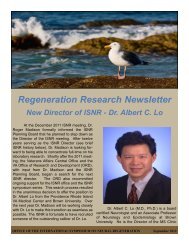Pharmacotherapy for posttraumatic stress disorder - Rehabilitation ...
Pharmacotherapy for posttraumatic stress disorder - Rehabilitation ...
Pharmacotherapy for posttraumatic stress disorder - Rehabilitation ...
You also want an ePaper? Increase the reach of your titles
YUMPU automatically turns print PDFs into web optimized ePapers that Google loves.
tricyclic antidepressants (TCAs), such as imipramine and<br />
amitriptyline, and the monoamine oxidase inhibitors<br />
(MAOIs), such as phenelzine—medications that are effective<br />
but have a less favorable side effect profile than SSRI<br />
or SNRI medications. The second-line agents also include<br />
antidepressants with weaker evidence of effectiveness,<br />
such as mirtazapine, or medications effective <strong>for</strong> PTSD but<br />
associated with rare but potentially dangerous side effects,<br />
such as nefazodone because of its hepatotoxicity.<br />
The main reason the TCAs and MAOIs are no longer<br />
used <strong>for</strong> depression and anxiety <strong>disorder</strong>s is their low<br />
therapeutic index. The difference between their therapeutic<br />
and toxic dosages is relatively small. As a general<br />
rule, TCA overdose can be lethal when the ingested dose<br />
exceeds 2–3 g, and this amount roughly corresponds to a<br />
30-day supply of the TCA at a dose of 75–100 mg daily.<br />
Interestingly, there is evidence of cardiac conduction prolongation<br />
with citalopram, a drug in the SSRI family,<br />
above dosages of 40 mg daily or in overdose [52–53].<br />
Early studies showed both the TCAs and MAOIs to be<br />
effective in PTSD, though the outcome measures in those<br />
707<br />
JEFFREYS et al. <strong>Pharmacotherapy</strong> <strong>for</strong> PTSD<br />
Table.<br />
Recommended first-line and second-line pharmacotherapy agents <strong>for</strong> treating <strong>posttraumatic</strong> <strong>stress</strong> <strong>disorder</strong> (PTSD). Adapted from Department of<br />
Veterans Affairs/Department of Defense Clinical Practice Guideline <strong>for</strong> Management of Post-Traumatic Stress.<br />
Strength of<br />
Recommendation * Substantial Benefit Some Benefit Unknown Benefit No Benefit or Harm<br />
A SSRIs, SNRIs — — —<br />
B — Mirtazapine, TCAs,<br />
MAOIs (phenelzine),<br />
prazosin (nightmares),<br />
nefazodone<br />
(caution)<br />
— —<br />
C — — Prazosin (PTSD) —<br />
D — — — Guanfacine, topiramate,<br />
valproate, tiagabine, benzodiazepines<br />
(harm), risperidone<br />
(adjunct)<br />
I — — Buspirone, bupropion, non-benzodiazepine,<br />
hypnotics, lamotrigine,<br />
gabapentin, clonidine, trazodone<br />
(adjunct), atypical antipsychotics<br />
(mono), atypical antipsychotics<br />
(besides risperidone, adjunct),<br />
conventional antipsychotics,<br />
Propranolol<br />
—<br />
*A = strongly recommend providing <strong>for</strong> eligible patients; B = recommend providing <strong>for</strong> eligible patients; C = no recommendation <strong>for</strong> or against providing <strong>for</strong> eligible<br />
patients; D = recommend against providing; I = insufficient evidence to recommend <strong>for</strong> or against providing <strong>for</strong> eligible patients.<br />
MAOI = monoamine oxidase inhibitor; SNRI = serotonin-norepinephrine reuptake inhibitor; SSRI = selective serotonin reuptake inhibitor; TCA = tricyclic<br />
antidepressant.<br />
early studies had less sensitivity and specificity than outcome<br />
measures in more recent studies [54–55]. Adding to<br />
the complexity with MAOIs are the relatively high rates<br />
of hypotension and the stringent restrictions <strong>for</strong> a<br />
tyramine-free diet to prevent hypertensive crisis. Potential<br />
interactions with other prescriptions must be<br />
observed with MAOI use as well.<br />
Mirtazapine acts through the serotonin system and<br />
can be a useful alternative to the SSRIs and venlafaxine.<br />
Mirtazapine’s primary side effect, sedation, can be therapeutically<br />
useful <strong>for</strong> some patients [56]. At higher dosages,<br />
it adds noradrenergic stimulation and demonstrates<br />
more activating effects. Its sexual side effects are often<br />
lower than the SSRIs as well, making it an attractive<br />
alternative <strong>for</strong> patients who report this problem. Weight<br />
gain can be a potential problem and must be considered<br />
especially in diabetic patients or those at risk <strong>for</strong> metabolic<br />
syndrome.<br />
Nefazodone acts to block reuptake of serotonin as<br />
well as postsynaptic receptors. It has been helpful in<br />
PTSD and can also target hyperarousal symptoms, such

















